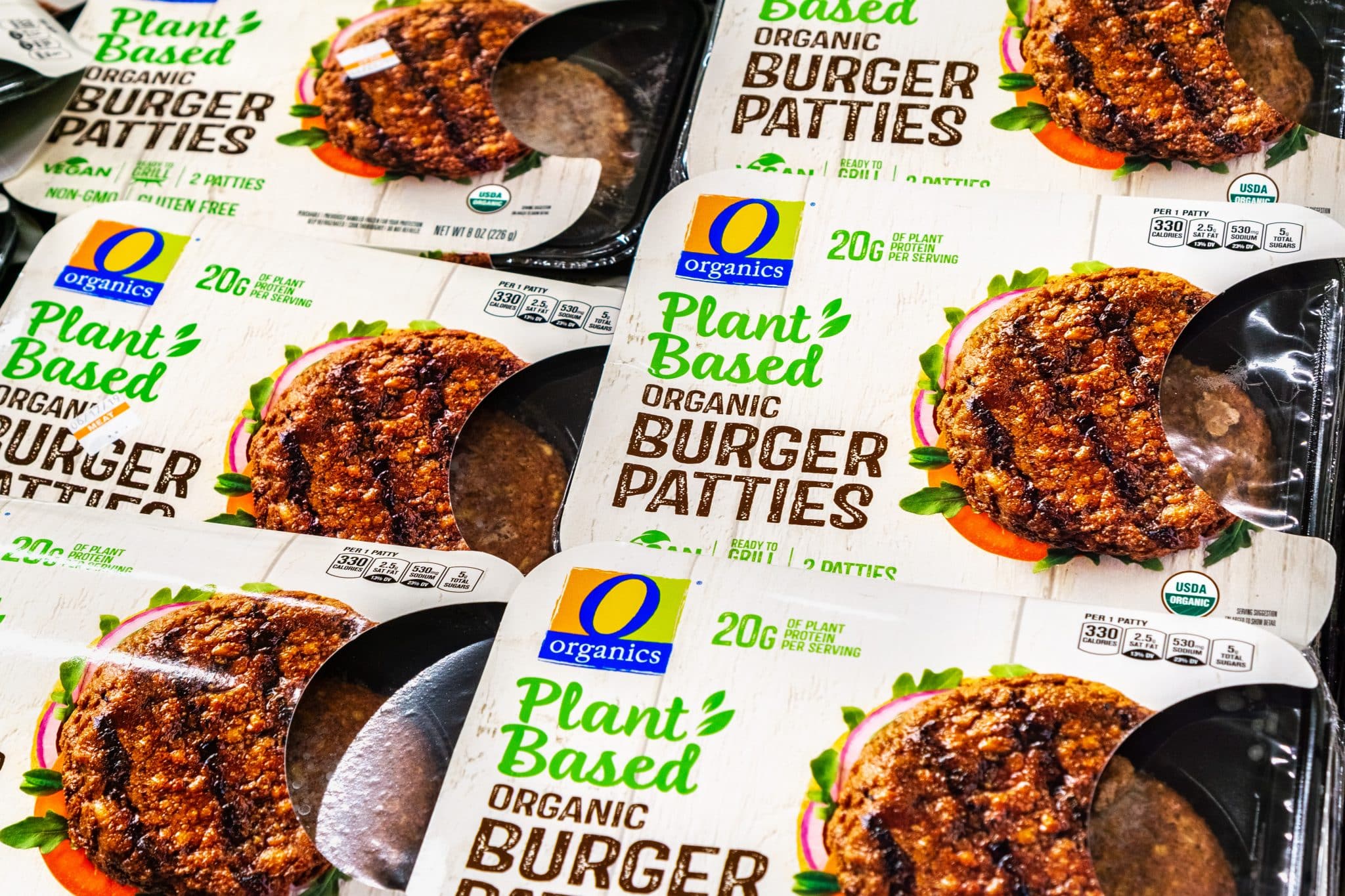Introduction
Flexitarians account for up to 90% of sales of plant-based alternatives.1 For brands and retailers seeking mainstream success for their plant-based products, this is the demographic to target. But when it comes to using organic ingredients, the question is: do flexitarians care?
To get a quick overview, let’s look at organic farming output and retail sales across the Global North. These figures are from the most recent year available, which was 2020. In terms of farming output, only 9.1% of utilised farmable land in the EU was used for organic farming.2 According to this survey, Denmark leads in Europe with organic shares taking up 13% of the total market, while the Austrian organic market takes up 11.3%, followed by Switzerland at 10.8%.3 While these figures clearly represent a minority of food produce, they are part of a consistent upward trend in demand for organic foods.
Over the past 20 years, demand for organic products has grown continuously across the Global North.4 In that same period, demand for plant-based alternatives has also grown significantly. In 2020, US retail sales of plant-based food grew twice as fast as overall food sales.5 Both plant-based and organic foods are on the up.
Aside from the trend data, there’s another reason to expect the organic food market to continue growing. The EU is aiming to increase the proportion of its organic farmland to 25% by 2030 and is making funds available to achieve this.6 Is now the time for plant-based brands to hop on the organic bandwagon?
In this article, we’ll outline the pros and cons of organic certification for plant-based products, along with examples of different brands’ approaches.
(By the way, for ease of reading, when we refer to plant-based products in this article, we mean products that are 100% vegan. For a deeper dive into the regional differences between the terms ‘plant-based’ and ‘vegan’, check out our dedicated article on terminology).
What does ‘certified organic’ mean?
In most developed markets, products that describe themselves as organic (or using organic ingredients) must be certified. The exact criteria vary between the EU and the US.
In the EU, organic certification prohibits the use of genetically modified organisms (GMOs), ionising radiation, and hormones. It also limits the use of artificial fertilisers, herbicides, pesticides, and antibiotics.7
In the US, the regulations are more relaxed. To be certified as organic, products only need to contain 95% organic content. These products must, however, demonstrate higher animal welfare and environmental standards compared to conventional foods.
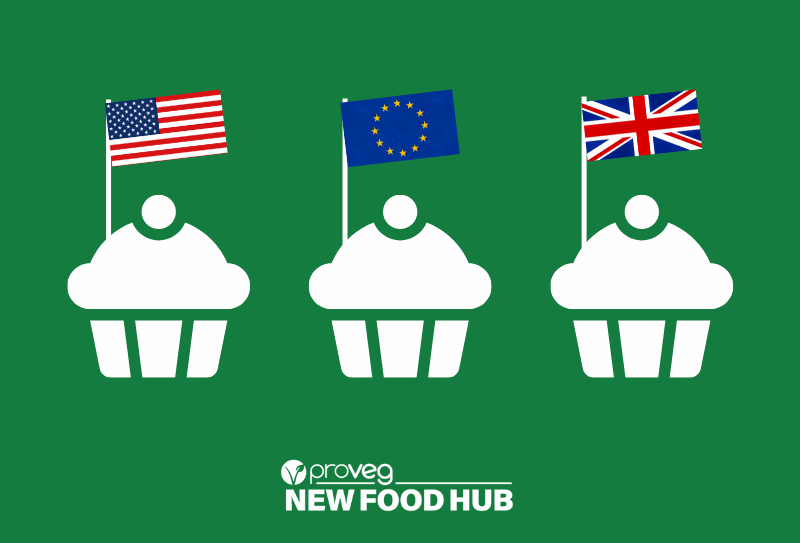
Regulations for organic ingredients vary between regions.
An even less stringent standard exists in the US called “made with”. It can be used for products containing at least 70% organic content – although such products are not eligible for the US Department of Agriculture (USDA) organic seal.8
Now that we’re clear on the regional differences between organic certifications, let’s get into the key issue for brands and retailers: what proportion of plant-based consumers care about organic ingredients?
Do flexitarians want plant-based alternatives to be organic?
Firstly, why are we focusing on flexitarian demand? Well, as we established in the introduction, flexitarians account for up to 90% of the sales of plant-based alternatives.9 They also represent around 30% of consumers worldwide.10 In the US, plant-based milk is regularly bought by over 40% of households and accounted for 16% of all retail dairy sales in 2021. Plant-based meats are regularly bought by around 20% of US households and accounted for around 3% of retail packaged-meat sales in the same year.11

The majority of people buying plant-based products don’t currently prioritise organic ingredients.
So where do organic products fit into this demand for plant-based alternatives? Well, according to data from Innova, the organic industry isn’t necessarily prioritising plant-based products. Their market research found that, of the organic products launched globally in 2021, 31% were gluten-free, and 29% were vegan.12 Inverse data showing the proportion of plant-based launches which were organic was not available at the time of writing.
To understand whether ‘organic plant-based’ is the right choice for your brand and target consumer, we need to explore the pros and cons of organic products and certification.
Reasons to make your plant-based product organic
1. Health benefits
Because organic foods have fewer synthetic inputs, they are perceived by many consumers as being a healthier alternative to conventionally farmed products. In fact, health is the number one reason consumers choose organic products.13
Some of these perceived benefits have been validated by independent studies, which found higher antioxidant properties,14 lower levels of toxic heavy metals,15 and less pesticide residue in organic products.16
However, other studies have raised questions about the validity of such health claims.171819 A 2017 meta-analysis of organic food studies found that, nutritionally speaking, “differences in the composition between organic and conventional crops are limited”, and that, looking at organic dairy and meat products, “differences are likely of marginal nutritional significance”.20
Other researchers have found that organic produce benefits heavily from the ‘halo effect’.2122 As researchers at Cornell University explain, “For some shoppers, organic foods benefit from a positive ‘health halo’ that leads them to perceive organic-labelled food as being higher in fibre, lower in fat and calories – and worth the higher cost.”23
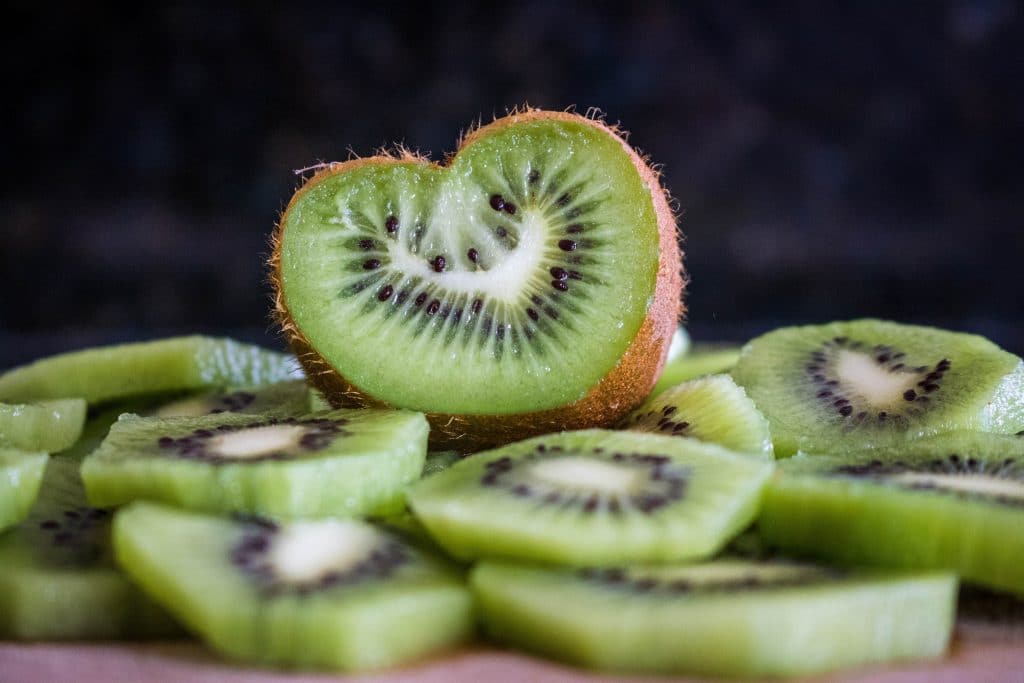
Health is the number one motivator for people buying organic products. It’s also a key flexitarian motivator. Is this a match made in heaven?
Organic connoisseurs aren’t the only health-seekers on the food scene. Health is a top motivation for flexitarians when choosing plant-based alternatives.24
This overlap hasn’t escaped the attention of many plant-based brands and goes some way to explaining the disproportionately high number of plant-based alternatives that are certified
organic. “What we found in Denmark is that when you put organic plant-based products on the shelves and communicate the difference, the products sell,” explained Paul Holmbeck, eco-consultant and former director of Organic Denmark, in an interview with ProVeg.
Based on our calculations above, organic certification is around four times more prevalent in vegan alternatives than in conventional food products. So if your plant-based alternative is targeting health-conscious foodies, then organic ingredients may be the way to go.
2. Taste
All consumers are motivated by taste, but this is especially true for many organic consumers. Taste and freshness are key motivators for people buying organic products.25
While several studies have found no scientific evidence to support the claim of superior organic taste,2627 a third of consumers nonetheless believe that organic foods taste better than conventional products.28

For regular organic consumers, superior taste is a key motivator.
This perception is reinforced by chefs and brands who do embrace organic ingredients, drawing on their anecdotal evidence. “Here’s the absolute truth on organic food: to me, it just tastes better,” states American chef and Spanish food specialist Jeffrey Weiss.29
In other words, if you’re a brand using organic ingredients, you might as well promote your perceived taste superiority, as it’s a self-fulfilling prophecy for many happy organic consumers!
3. Fewer chemicals and less energy
An extensive 2017 meta-analysis of organic farming methods found that they generally require less energy,30 and subsequent studies found they require fewer synthetic chemical inputs than intensive farming methods.3132 However, the 2017 meta-analysis found that organic farming requires more land, is more likely to cause eutrophication33 and acidification, and produces similar levels of greenhouse gas emissions to conventional agriculture.34 The overall environmental costs and benefits of organic versus conventional agriculture vary widely between types of crop and livestock, but on average appear to be similar.
As we mentioned in the introduction, the EU has two flagship umbrella schemes driving its sustainable farming agenda — these include the ‘Farm to Fork’ strategy and the Biodiversity strategy. Both of these strategies identify organic farming as a cornerstone solution, and are making funding available to increase the proportion of organic farmed land from 9.1% in 2020 to 25% by 2030.35 However, a 2021 study found that to achieve this, EU law will have to change to allow new innovative biotechnology techniques as part of the organic solution, otherwise, the move could risk making farming less sustainable overall.36
4. Demographics
Sales of organic products grew by 21% from 2021–22.37 “Sales of plant-based foods/drinks with organic ingredients grew 28% for the year ended Jan. 21, 2021, per SPINS.”38
In the US, Millennials are now the largest generation and consumer segment. A 2019 study found that organic produce is a leading priority for almost 40% of these consumers – placing it narrowly above plant-based produce.39 The closeness of the two priorities suggests a potential overlap in interests among this demographic, who are seeking both plant-based and organic products in one.
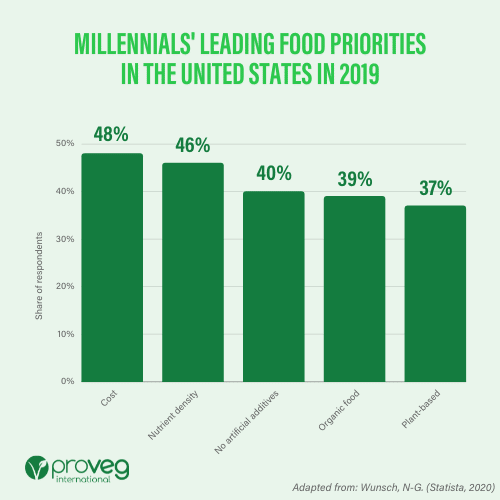
Although this study didn’t establish a causal relationship, it appears likely there is an overlap among Millennial consumers in the US who share a desire for organic and plant-based products.
Now that we’ve established the key reasons consumers value organic plant-based products, let’s look at some brands’ attitudes. Do they align?
Case studies: organic vs bioengineered plant-based alternatives
Most brands that choose organic do so because they believe it is a significant value-add for their consumers. In Denmark, per capita consumer spending on organic products is higher than in any other nation, coming in at 12.1% – more than double the US market average.40 It’s significant, then, that this ratio is substantially higher once again for plant-based alternatives. According to Paul Holmbeck, former director of Organic Denmark, organic products account for 65% of dairy alternatives on the Danish market.
For us it’s really important to have good ingredients – good, organic-certified raw materials to work with – because consumers care about where a product is made and what’s in it.”
Alexander Eder, the co-founder of vegan brand Planty of Meat (DE), emphasises this consumer-centric approach.
But how should brands communicate the benefits of organic to consumers?
British tofu company The Tofoo Co. uses its organic certification playfully in its online marketing materials. When describing their 100% organic, natural tofu, they explain, “When we think of a delicious Tofoo dinner we don’t think of it with a side of pesticides.”41

The Tofoo Co. strongly promotes its organic credentials by including both the organic certification logo and a prominent ‘organic,’ subheading on its front-of-pack.
If your brand has a strong food-service presence alongside retail, you may have even greater access to the premium food market, where organic products generally do better. Breads on Oak is a bakery/restaurant in Louisiana (US) that turned fully vegan and organic around 2018. The bakery has built a strong reputation among health-conscious, plant-based consumers, and advertises itself as providing “delicious organic plant-based food”.42 The popularity of organic ingredients can also be seen in Denmark, where, according to Paul Holmbeck, former director of Organic Denmark, they’re now “way over 90% plant-based organic in public-sector catering in Copenhagen. I appeal to the plant-based movement to work more closely with the organics movement. There’s just so much commonality between those agendas.”
The organic lobby has been working hard to capitalise on consumer perceptions of organic foods’ health benefits. In 2020 the US introduced a law requiring all products containing genetically modified ingredients to carry a consumer-warning badge on their products. This became mandatory in early 2022, and has impacted the world’s second-largest producer of plant-based meat alternatives, Impossible Foods.

From 2022 all food products in the US containing genetically modified ingredients must carry one of these labels. Will consumers be put-off?
Products from Impossible Foods and other brands using GMO ingredients must now carry a ‘bioengineered’ label on their products. It’s too early to tell whether this will have a significant impact on mainstream sales, but at the least, it’s likely to provide a barrier for flexitarians who were previously on the fence about the organic issue.43
At the EU level, almost 60 GMO crops have been approved for cultivation and consumption by humans and animals.44 However, the majority of member states have long exercised their right to ban GMO farming in their individual countries.45Thus, only a handful of countries are actively growing GMO crops in Europe and at relatively small scales. If consumer attitudes and legislation were to change across EU member states, then EU labelling regulations for GMO products could become a relevant barrier to consumer adoption.46 For now, the jury is out!
Action for businesses:
- Research your target consumers to understand how important health is to them, and whether organic ingredients are a purchasing motivator for them.
- Research the competitors in your category. Is organic certification an opportunity to differentiate your product? Or is it already a consumer expectation?

ProVeg Tips
Unsure where to start? Talk to ProVeg — we work with businesses across the value chain across Europe and the US. Our consumer insights and marketing expertise can help your plant-based products to thrive. To get started, reach out to us at [email protected].
Cons of organic certification
1. Organic production costs are higher
One of the greatest challenges for organic producers is the yield gap. Multiple studies from the last decade have found that organic crops produce around 25% less food than conventional crops.474849 That said, anecdotal evidence from organisations like the Förderkreis Biozyklisch-Veganer Anbau, a biocyclic-farming NGO based in Germany and interviewed by ProVeg, suggests that recent advances in plant-based organic techniques have closed the yield gap. Over time, this may help to reduce the price premium too, and make organic products accessible to a wider range of consumers.
Organic arable farming can be more labour intensive than conventional arable farming.50 At the same time, organic farming reduces yields relative to land size.51 The certification process is also time-consuming, rigorous, and expensive for farmers. This combination of factors increases overall food production costs.52
The pricing problem is compounded by the hefty premium applied by both producers and retailers. In the UK, consumers pay an average premium of 89% on organic products.53 Only a small minority of consumers can afford that kind of price difference, making organic products the reserve of wealthier shoppers.
It’s an outrage that supermarkets intentionally make more profit from plant-based and organic products, [retailers are] intentionally excluding less-affluent shoppers from accessing those ranges.”
This situation is compounded for plant-based alternatives, where retailers already apply a 30–50% margin (compared to just 4–8% for animal-based versions).54 If all plant-based brands were to go organic, this double premium would make organic, plant-based foods unaffordable to most western consumers, let alone those in the Global South.

Are growers, brands and retailers ready to cooperate on making organic products affordable for mainstream consumers?
For instance, India is one of the world’s largest producers of organic food. Yet less than 1% of Indian domestic food purchases are organic – the products are simply too expensive for locals. Instead, the majority of organic produce is exported to wealthier western markets.55
On the other hand, for those who can afford it, the perceived additional benefits of organic products make the premium worth paying. As Paul Holmbeck, eco consultant and former director of Organic Denmark noted in an interview with ProVeg, “the fact is, when retailers do put organic products on the shelves with a premium, they get bought.”
If your brand prides itself on social responsibility, then it’s worth considering how to balance the perceived environmental and health benefits of organic ingredients against the potentially exclusionary pricing implications for the majority of consumers.
2. Organic farming is not scalable
In the current global food system, organic farming isn’t scalable. Why? Because the vast majority of arable land is used as feed for intensive livestock. A 2019 study found that converting all UK domestic crop and livestock production to 100%-organic methods would cause a net increase in greenhouse gas emissions (GHGs), because it would produce insufficient food yields to maintain current western diets and thus would require more food imports. This would in turn drive up overseas food production, and thus increase GHGs as more land is cleared for agriculture.56
“Feeding the planet organically [on current meat-intensive diets] would require widespread deforestation and an additional Earth to farm, so is not a scalable solution,” explains the Behavioural Insights Team (an international think tank).57
Organic farming is only scalable if the world drastically reduces its consumption of animal-based meat (see below). A 2020 study found that if food-producer prices were adjusted to reflect their GHGs, then conventional and organic farming prices would have to increase by 146% and 71% respectively, and conventional dairy prices by 91%. By contrast, organic, plant-based products would only require a 6% uplift.58 In other words, organic methods are only climate positive and scalable when they’re facilitating a predominantly plant-based diet. 5960To give an example of the scale, replacing beef with beans in the US would provide the same protein benefits while freeing up 42% of the country’s farmland.61

In the EU, milk, dairy, and eggs account for 83% of an individual’s dietary emissions.62
In North America, people get around 30% of their daily calories from animal-based products.63 However, according to the EAT-Lancet Commission, a flexitarian diet that’s both healthy and sustainable for the planet should get no more than 12% of its daily calories from animal-based products.64 According to research by ProVeg International, to meet climate targets, average European citizens need to reduce their consumption of meat and dairy by around 80% by 2040.65
Only by reducing global meat consumption can we free up enough farmland for organic crop cultivation in a way that will deliver net environmental and climate benefits.
The good news is that there is growing awareness worldwide that, if we are to meet international climate targets, food-system reform is essential. A 2022 study by the University of Bonn warns that rich countries must reduce their meat consumption by up to 75% to avoid further climate disaster.66 If a reduction in farmed meat becomes part of global emissions-reduction targets, this would present a huge opportunity for organic plant-based farming to proliferate.
3. Organic seeds can be scarce
According to the European Food Information Council (EFIC), a seed is considered organic if its parent plant has been grown organically for at least one generation. A current challenge for brands looking to source organic plant-based ingredients is the low supply of organic seeds. The supply of organic seeds is a bottleneck for farmers and brands looking to transition.
The good news, according to EFIC, is that the range of organic crops available has expanded over the last 20 years thanks to alternative propagation methods and investment in organic seed production by farmers.67
4. Flexitarians don’t care about organic
As our introductory analysis showed, the majority of plant-based consumers are flexitarians who don’t seem to care about whether products are organic or not. The market seems to confirm this.
The two biggest plant-based meat brands are Beyond Meat and Impossible Foods, and neither uses organic ingredients. However, lack of organic certification hasn’t stopped these two giants from achieving explosive international growth over the past decades.
Alternative ways to differentiate your brand
Be uncertified but quietly organic?
As we’ve established, organic certification can bring a number of downsides, like higher prices. It can also increase your supply-chain risk, as it reduces the number of ingredient suppliers you can rely on for a given product. “Be careful about going organic,” warns Heather Mills, CEO and founder of plant-based food brand V-bites (UK). “We were organic at the start, but it leaves you vulnerable to a shortage of one niche organic ingredient.”
What is Mills’ suggested solution? “Better to be organic by design but not advertise it.”
If you do still want to reach those super-health-conscious flexitarians, then there are alternative health-positive messages you can communicate instead of organic status.
For instance, small farmers who don’t have the resources for organic certification often market their produce as ‘unsprayed’ or ‘spray-free’ instead, as these terms aren’t regulated in the same way.68

This stuff’s organic… Shhh… Don’t tell anyone!
Use non-GMO crops
Another way is to side-step the issue completely. Beyond Meat uses non-GMO plants in its ingredients. This doesn’t make the brand organic, but it does differentiate Beyond from its main rival, Impossible. This benefit also helped Beyond Meat become the first of the pair to enter the EU market.69

Babe, check it out – this plant-based burger’s om-nom-non-GMO!
Consider biocyclic organic methods
If your brand is motivated by environmental sustainability, animal welfare, or health benefits arising from organic farming methods, ProVeg recommends that you work with your suppliers to introduce biocyclic farming methods across their farms.
This style of organic farming doesn’t require inputs from farmed animals. Farmers use green manure crops instead of livestock waste. These include plants like clover, rice, rye, and nitrogen-fixing legumes which improve soil fertility. Farmers can also use intercropping methods, using crops like buckwheat alongside other organic crops to inhibit weeds and reduce soil erosion. For pest control, ladybugs and wasps offer a natural solution, while neem, garlic, and chilli pepper can act as natural pest repellants. There are also mechanical interventions available, like netting and bagging, to protect fruits and vegetables as they grow.70
If you’re interested in farmers’ perspectives on transitioning to alternative proteins and topics like biocyclic and regenerative agriculture, check out our detailed report: Amplifying farmers’ voices.
Go clean label
Brands who are still debating organic certification, or who are in the process of achieving it, may opt to prioritise clean-label ingredients. This side-steps the issue of organic vs non-organic and focuses on the idea of ‘natural’ vs synthetic.
“Clean label is basically why we started the company,” explains Pascal Bieri, co-founder of Planted Foods (CH), speaking in an interview with ProVeg. “I was missing products with ingredients I actually recognised as a consumer.” Planted Foods is in the process of certifying its plant-based chicken alternative as organic.71 In the meantime, they’re vocal about the non-synthetic nature of their foods, promoting their recipes as using “selected, 100% natural ingredients”.72

Planted markets the clean-label credentials of its chicken alternative, rather than relying on organic certification. The website and packaging boasts a recipe of just ‘four natural ingredients’: pea protein, pea fibre, rapeseed oil, and water.73
Clean label is likely to become a more mainstream concept and stronger selling point for plant-based alternatives as new fermentation-derived proteins enter the market in the next two to three years. To find out more, check out our article: 7 key development strategies for plant-based products.
Network at organic trade fairs
Organic trade fairs exist worldwide, and many of them now have dedicated sections and talks for plant-based brands to promote their products.
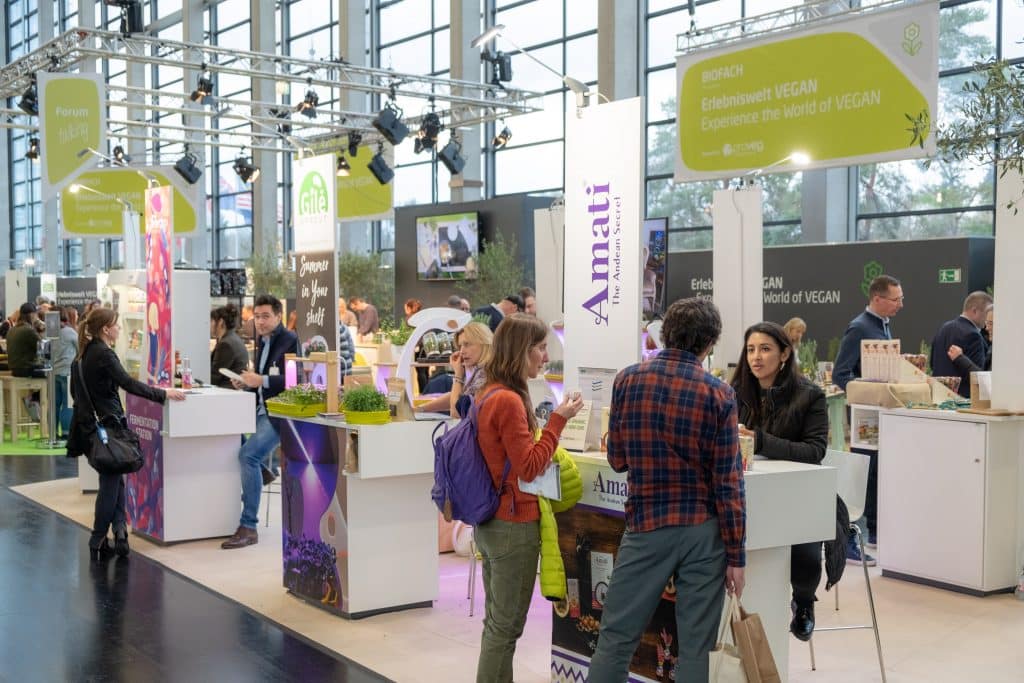
The dedicated plant-based section at the Biofach organic trade fair (pictured in 2020 above) has continued to grow since its introduction a few years ago.
Consider attending or networking at organic trade fairs, many of which have dedicated plant-based sections – for instance, Biofach in Nuremberg, Germany (the world’s biggest organic food trade fair), and NOPE in London, UK. There are also dedicated trade fairs for vegan food like the Plant-Based World Expo, and the annual ProVeg New Food Conference in Germany, where organic, plant-based brands can differentiate themselves from other plant-based alternatives in their category.
When ProVeg attended Biofach in 2020, we found that there was a significant commercial opportunity for organic, plant-based brands to develop high-quality meat alternatives. While the organic dairy alternatives were prevalent and popular, we found that there was still an opportunity for organic, plant-based meats to get closer to the properties of their conventional counterparts.74 Perhaps your brand is ready to step-up?

ProVeg is an active participant at Biofach organic trade fair (picture is from our last visit in February 2020, pre-pandemic. We’ll be back!)
Action for brands:
- If you don’t see organic certification as relevant to your consumers, but you do value the methodology, then biocyclic, organic farming without certification could be the best compromise for your brand.
- If you’re not organically certified, but use organic farming methods, you could communicate these benefits to consumers through the less-regulated terms ‘unsprayed’ or ‘spray-free’, or by highlighting that your product is “non-GMO’.
- Consider networking at international organic trade fairs — many of them now have dedicated plant-based sections.
Conclusion
Overall, our evidence suggests that for the majority of plant-based consumers and brands, organic ingredients are not a priority.
- The majority of flexitarians are agnostic when it comes to organic produce.
- Organic farming can be detrimental to the environment in some circumstances, the certification is expensive, and it adds risk to your supply chain.
- Biocyclic, vegan, organic farming can be a great way to reduce synthetic inputs and maintain crop yields without relying on animal agriculture, but you’ll need to work with your suppliers to help them access financing and advice on transitioning.
- If your brand is positioning its product as a health food, then organic certification makes sense for your target demographic. Despite the hefty price premium, it is likely to appeal to them without alienating other consumers.
Developing and launching a plant-based product requires the perfect mix of preparation, innovation, hard work, and promotion. ProVeg can help you to succeed across the entire process of taking your product to market. We have extensive experience of flexitarian consumers across Europe, and we work across the entire value chain. To find out how we can help take your plant-based product to the next level, get in touch at [email protected].
Note: ProVeg conducts exclusive interviews with a wide range of industry professionals for its New Food Hub white papers. Unless an alternative citation is provided, quotations are from those interviews. Some interviewees wished to remain anonymous.
References
- The NPD Group (2019): Plant-based Foods: Will They Stay or Will They Go? Available at: https://www.npd.com/news/press-releases/2019/plant-based-foods-will-they-stay-or-will-they-go/ Accessed 2022-04-07
- Eurostat (2022): Organic farming statistics. Available at: https://ec.europa.eu/eurostat/statistics-explained/index.php?title=Organic_farming_statistics#Key_messages Accessed 2022-05-20
- Forschungsinstitut für biologischen Landbau FiBL (2022): The World of Organic Agriculture 2022. Available at: https://www.fibl.org/fileadmin/documents/shop/1344-organic-world-2022.pdf Accessed 2022-05-31
- Forschungsinstitut für biologischen Landbau FiBL (2022): The World of Organic Agriculture 2022. Available at: https://www.fibl.org/fileadmin/documents/shop/1344-organic-world-2022.pdf Accessed 2022-05-31
- Good Food Institute (2021): 2020 U.S. retail market data for the plant-based industry. Available at: https://gfi.org/marketresearch/ Accessed 2022-05-20
- Cuoco, E. (2022): The Farm to Fork strategy and EU Organic Action Plan. Organic Cities. Available at: https://www.organic-cities.eu/2022/02/09/the-farm-to-fork-strategy-and-eu-organic-action-plan/ Accessed 2022-05-20
- European Commission (n.d.): Organic production and products. Available at: https://ec.europa.eu/info/food-farming-fisheries/farming/organic-farming/organic-production-and-products_en#organicproductionrules Accessed 2022-04-07
- Agricultural Marketing Service (n.d.): About the Organic Standards. U.S. Department of Agriculture. Available at: https://www.ams.usda.gov/grades-standards/organic-standards Accessed 2022-04-07
- The NPD Group (2019): Plant-based Foods: Will They Stay or Will They Go? Available at: https://www.npd.com/news/press-releases/2019/plant-based-foods-will-they-stay-or-will-they-go/ Accessed 2022-04-07
- Smart Protein Project (2021): ‘What consumers want: A survey on European consumer attitudes towards plant-based foods. Country specific insights’ European Union’s Horizon 2020 research and innovation programme (No 862957). Available at: https://smartproteinproject.eu/consumer-attitudes-plant-based-food-report/ Accessed 2022-06-10
- Ignaszewski, E. (2022): 2021 U.S. Retail Market Insights: Plant-based foods. Good Food Institute. Available at: https://gfi.org/wp-content/uploads/2022/03/2021-U.S.-retail-market-insights_Plant-based-foods-GFI.pdf Accessed 2022-05-23
- Food Ingredients First (2022): Organic trends: Health, sustainability, protein ingredients driving innovation. Available at: https://www.foodingredientsfirst.com/news/organic-trends-health-sustainability-protein-ingredients-driving-innovation.html Accessed 2022-05-20
- Gundala, R. R., &, Singh, A. (2021): What motivates consumers to buy organic foods? Results of an empirical study in the United States. PLOS ONE. Available at: https://doi.org/10.1371/journal.pone.0257288 Accessed 2022-05-03
- Benbrook, C. (2014): New Meta-Analysis Identifies Three Significant Benefits Associated With Organically Grown Plant-Based Foods. Center for Sustaining Agriculture and Natural Resources, Washington State University. Available at: https://csanr.wsu.edu/significant-benefits-organic-plant-based-foods/ Accessed 2022-04-07
- Dotse, C. K. (2010): Assessing Commercial Organic and Conventionally Grown Vegetables by Monitoring Selected Heavy Metals Found in Them. East Tennessee State University. Available at: https://dc.etsu.edu/cgi/viewcontent.cgi?article=3070&context=etd Accessed 2022-04-07
- Agricultural Marketing Service (2012): 2010 – 2011 Pilot Study Pesticide Residue Testing of Organic Produce. United States Department of Agriculture.Available at: https://www.ams.usda.gov/sites/default/files/media/Pesticide%20Residue%20Testing_Org%20Produce_2010-11PilotStudy.pdf Accessed 2022-04-07
- Richetin, J., Caputo, V., Demartini, E., Conner, M.m & Perugini, M. (2022): Organic food labels bias food healthiness perceptions: Estimating healthiness equivalence using a Discrete Choice Experiment. Appetite 172. Available at: https://doi.org/10.1016/j.appet.2022.105970 Accessed 2022-06-10
- Huber, M., Rembiałkowska, E., Średnicka, D., Bügel, S. & van de Vijver L. P. L. (2011): Organic food and impact on human health: Assessing the status quo and prospects of research. NJAS: Wageningen Journal of Life Sciences, 58:3-4, 103-109. Available at: https://doi.org/10.1016/j.njas.2011.01.004 Accessed 2022-06-10
- Mesnage, R., Tsakiris, I. N., Antoniou, M. N. & Tsatsakis, A. (2020): Limitations in the evidential basis supporting health benefits from a decreased exposure to pesticides through organic food consumption. Current Opinion in Toxicology 19. Available at: https://doi.org/10.1016/j.cotox.2019.11.003 Accessed 2022-06-10
- Mie, A., H. R. Andersen, S. Gunnarsson, et al. (2017): Human health implications of organic food and organic agriculture: a comprehensive review. Environmental Health 16(1), 111. Available at: https://doi.org/10.1186/s12940-017-0315-4 Accessed 2022-6-10
- Lamonaca, E., Cafarelli, B., Calculli, C., & Tricase, C. (2022): Consumer perception of attributes of organic food in Italy: A CUB model study. Heliyon 8:3. Available at: https://doi.org/10.1016/j.heliyon.2022.e09007 Accessed 2022-06-10
- Bschaden, A., Schulz, J. & Stroebele-Benschop, N. (2022): The sustainability halo effect: Does the provision of sustainability information of a snack affect sensory and health perception, and willingness to pay?. Future Foods 5. Available at: https://doi.org/10.1016/j.fufo.2022.100143
- Cornell Chronicle (2011): ‘Organic’ food labels create perception of healthier fare. Cornell University. Available at: https://news.cornell.edu/stories/2011/04/organic-food-label-imparts-health-halo-study-finds Accessed 2022-05-16
- Smart Protein Project (2021): ‘What consumers want: A survey on European consumer attitudes towards plant-based foods. Country specific insights’ European Union’s Horizon 2020 research and innovation programme (No 862957). Available at: https://smartproteinproject.eu/consumer-attitudes-plant-based-food-report/ Accessed 2022-06-10
- Gundala, R. R., &, Singh, A. (2021): What motivates consumers to buy organic foods? Results of an empirical study in the United States. PLOS ONE. Available at: https://doi.org/10.1371/journal.pone.0257288 Accessed 2022-05-03
- Fillion, L. & Arazi, S. (2002): Does organic food taste better? A claim substantiation approach. Nutrition & FooD Science 32(4):153-157. Available at: https://www.researchgate.net/publication/242000272_Does_organic_food_taste_better_A_claim_substantiation_approach Accessed 2022-05-16
- Pew Research Center (2016): Americans’ views about and consumption of organic foods. Available at: https://www.pewresearch.org/science/2016/12/01/americans-views-about-and-consumption-of-organic-foods/ Accessed 2022-05-16
- Pew Research Center (2016): Americans’ views about and consumption of organic foods. Available at: https://www.pewresearch.org/science/2016/12/01/americans-views-about-and-consumption-of-organic-foods/ Accessed 2022-05-03
- Weiss qtd. in Walsh, C. (2016): Chefs Chime in On: The Organic Movement. Foodable Network. Available at: https://www.foodabletv.com/blog/2016/3/23/chefs-chime-in-on-the Accessed 2022-05-16
- Clark, M. & Tilman, D. (2017): Comparative analysis of environmental impacts of agricultural production systems, agricultural input efficiency, and food choice. Environmental Research Letters 12(6). Available at: https://iopscience.iop.org/article/10.1088/1748-9326/aa6cd5 Accessed 2022-06-10
- Dhar, A. D., Uddin, M. T., & Roy, M. K. (2020): Assessment of organic shrimp farming sustainability from economic and environmental viewpoints in Bangladesh. Environmental Research 180(108879). Available at: https://doi.org/10.1016/j.envres.2019.108879 Accessed 2022-06-10
- Boone, L., Roldán-Ruiz, I., van Linden, V., Muylle, H., & Dewulf, J. (2019): Environmental sustainability of conventional and organic farming: Accounting for ecosystem services in life cycle assessment. Science of The Total Environment 695:133841. Available at: https://doi.org/10.1016/j.scitotenv.2019.133841 Accessed 2022-06-10
- ‘The gradual increase in the concentration of phosphorus, nitrogen, and other plant nutrients in an ageing aquatic ecosystem such as a lake… Eutrophic waters are often murky and may support fewer large animals, such as fish and birds, than non-eutrophic waters.’ Source: https://www.britannica.com/science/eutrophication Accessed: 2022-06-28
- Clark, M., & Tilman, D. (2017): Comparative analysis of environmental impacts of agricultural production systems, agricultural input efficiency, and food choice. Environmental Research Letters 12(6). Available at: https://iopscience.iop.org/article/10.1088/1748-9326/aa6cd5 Accessed 2022-06-10
- Cuoco, E. (2022): The Farm to Fork strategy and EU Organic Action Plan. Organic Cities. Available at: https://www.organic-cities.eu/2022/02/09/the-farm-to-fork-strategy-and-eu-organic-action-plan/ Accessed 2022-05-20
- Purnhagen, K. P., Clemens, S. & D. Eriksson, et al. (2021): Europe’s Farm to Fork Strategy and Its Commitment to Biotechnology and Organic Farming: Conflicting or Complementary Goals? Trends in Plant Science 26(6). Available at: https://doi.org/10.1016/j.tplants.2021.03.012 Accessed 2022-06-10
- Dicker, S. (2021): New Data: Sustainable Shoppers Want Organic Products and Zero-Waste Packaging. SPINS. Available at: https://www.spins.com/resources-sustainable-shoppers-wan-organic-products-zero-waste-packaging/ Accessed 2022-05-20
- Sloan, A. E. (2021): What to Watch for as the Plant-Based Food Market Grows. Institute of Food Technologists. Available at: https://www.ift.org/news-and-publications/food-technology-magazine/issues/2021/august/columns/consumer-trends-plant-based-food-market Accessed 2022-05-20
- Wunsch, N-G. (2020): Millennials’ leading priorities when it comes to food US 2019. Statista. Available at: https://www.statista.com/statistics/1188402/millennials-in-the-us-top-food-priorities/ Accessed 2022-05-20
- Food Nation Denmark (n.d.): Denmark secures a new world record – we spend most on organic food. Available at: https://foodnationdenmark.com/news/denmark-secures-a-new-world-record-we-spend-most-on-organic-food Accessed 2022-05-16
- The Tofoo Co. (n.d.): Ingredients: Is your Tofoo organic? Available at: https://tofoo.co.uk/faqs/ Accessed 2022-04-07
- Breads on Oak (n.d.): Breads on Oak. Available at: https://www.breadsonoak.com/ Accessed 2022-05-03
- Poinski, M. (2020): Food manufacturers can put GMO labels on their products in 2020. Will they? Food Dive. Available at: https://www.fooddive.com/news/food-manufacturers-can-put-gmo-labels-on-their-products-in-2020-will-they/570505/ Accessed 2022-04-07
- European Commission (n.d.): Several European countries move to rule out GMOs. Available at: https://ec.europa.eu/environment/europeangreencapital/countriesruleoutgmos/ Accessed 2022-05-20
- European Parliament (2015): Eight things you should know about GMOs. Available at: https://www.europarl.europa.eu/news/en/headlines/society/20151013STO97392/eight-things-you-should-know-about-gmos Accessed 2022-05-20
- European Commission (2004): Question and Answers on the regulation of GMOs in the EU. Available at: https://ec.europa.eu/commission/presscorner/detail/en/MEMO_04_102 Accessed 2022-05-20
- Niggli, U. (2015): Sustainability of organic food production: Challenges and innovations. Proceedings of the Nutrition Society 74(1): 83-88. Available at: https://doi.org/doi:10.1017/S0029665114001438 Accessed 2022-06-10
- Seufert, V., Ramankutty, N. & Foley, J. A. (2012): Comparing the yields of organic and conventional agriculture. Nature 485(7397): 229–232. Available at: https://doi.org/10.1038/nature11069 Accessed 2022-06-10
- de Ponti, T., Rijk, B. & van Ittersum, M. K. (2012): The crop yield gap between organic and conventional agriculture. Agricultural Systems 108: 1–9. Available at: http://dx.doi.org/10.1016/j.agsy.2011.12.004 Accessed 2022-06-10
- Orsini, S., Padel, S. & Lampkin, N. (2018): Labour Use on Organic Farms: a Review of Research since 2000. Organic Farming 4:1. Available at https://doi.org/10.12924/of2018.04010007 Accessed 2022-10-06
- Knapp, S. & van der Heijden, M. G. A. (2018): A global meta-analysis of yield stability in organic and conservation agriculture. Nature Communications 9. Available at: https://doi.org/10.1038/s41467-018-05956-1 Accessed 2022-06-10
- Food and Agriculture Organisation of the United Nations (n.d.): Organic Agriculture FAQ. Available at: https://www.fao.org/organicag/oa-faq/oa-faq5/en/ Accessed 2022-06-10
- Beer, E. (2016): UK shoppers pay 89% more for organic food: survey. Food Navigator. Available at: https://www.foodnavigator.com/Article/2016/01/28/UK-shoppers-pay-89-more-for-organic-food-survey Accessed 2022-04-07
- ProVeg International (2022): 3 ways to achieve price parity and drive sales. Available at: https://corporate.proveg.com/article/3-ways-to-achieve-price-parity-and-drive-sales/ Accessed 2022-06-10
- Whitehead, RJ. (2018): Rich tastes: Why only the wealthy can afford India’s high-priced organics. Food Navigator. Available at: https://www.foodnavigator-asia.com/Article/2018/07/23/Rich-tastes-Why-only-the-wealthy-can-afford-India-s-high-priced-organics Accessed 2022-05-03
- Smith, L. G., Kirk, G. J. D., Jones, P. J. & Williams, A. G. (2019): The greenhouse gas impacts of converting food production in England and Wales to organic methods. Nature Communications 10. Available at: https://doi.org/10.1038/s41467-019-12622-7 Accessed 2022-06-10
- The Behavioural Insights Team (2020): A Menu for Change. Available at: https://www.bi.team/wp-content/uploads/2020/03/BIT_Report_A-Menu-for-Change_Webversion_2020.pdf.pdf Accessed 2022-04-08
- Pieper, M., Michalke, A. & Gaugler, T. (2020): Calculation of external climate costs for food highlights inadequate pricing of animal products. Nature Communications 11. Available at: https://doi.org/10.1038/s41467-020-19474-6 Accessed 2022-06-10
- Muller, A., Schader, C., El-Hage Scialabba, N., et al (2017): Strategies for feeding the world more sustainably with organic agriculture. Nature Communications 8. Available at: https://doi.org/10.1038/s41467-017-01410-w Accessed 2022-06-10
- Springmann, M., Clark, M., Mason-D’Croz, D., et al. (2018): Options for keeping the food system within environmental limits. Nature 562: 519–525. Available at: https://doi.org/10.1038/s41586-018-0594-0 Accessed 2022-05-23
- Harwatt, H., Sabaté, J., Eshel, G., et al. (2017): Substituting beans for beef as a contribution toward US climate change targets. Climatic Change 143:261-270. Available at: https://doi.org/10.1007/s10584-017-1969-1 Accessed 2022-06-10
- Sandström, V., Valin, H., Krisztin, T., Havlík, P., Herrero, M., & Kastner, T. (2018): The role of trade in the greenhouse gas footprints of EU diets. Global Food Security 19: 48-55. Available at: https://doi.org/10.1016/j.gfs.2018.08.007 Accessed 2022-05-23
- Rehkamp, S. (2016): A Look at Calorie Sources in the American Diet. USDA Economic Research Service. Available at: https://www.ers.usda.gov/amber-waves/2016/december/a-look-at-calorie-sources-in-the-american-diet/ Accessed 2022-05-23
- EAT-Lancet Commission (2019): Healthy Diets From Sustainable Food Systems. Available at: https://eatforum.org/content/uploads/2019/07/EAT-Lancet_Commission_Summary_Report.pdf Accessed 2022-05-23
- Diet Change Not Climate Change (n.d.): Reduction targets needed to hit climate targets. Available at: https://dietchangenotclimatechange.com/data/ Accessed 2022-05-23
- University of Bonn (2022): Meat consumption must fall by at least 75%. Available at: https://www.uni-bonn.de/en/news/082-2022 Accessed 2022-05-20
- EUFIC (2019): Organic plant-based food. Available at: https://www.eufic.org/en/food-production/article/organic-plant-based-food Accessed 2022-05-20
- Colquhoun, J. (2014): Organic Vs. Spray-Free – What Is The Difference? Food Matters. Available at: https://www.foodmatters.com/article/organic-vs-spray-free-what-is-the-difference Accessed 2022-05-03
- Beyond Meat (n.d.): Frequently Asked Questions. Available at: https://www.beyondmeat.com/en-GB/faqs Accessed 2022-04-07
- EUFIC (2019): Organic plant-based food. Available at: https://www.eufic.org/en/food-production/article/organic-plant-based-food Accessed 2022-05-20
- Planted Foods (n.d.): Frequently Asked Questions. Available at: https://en.eatplanted.com/faq Accessed 2022-05-16
- Planted Foods (n.d.): Our products. Available at: https://en.eatplanted.com/products Accessed 2022-05-16
- Planted Foods (n.d.): planted.chicken. Available at: https://en.eatplanted.com/chicken Accessed 2022-05-16
- Wiederkehr, V. (2020): Standout Plant-Based Products at Biofach 2020. ProVeg International. Available at: https://proveg.com/blog/standout-plant-based-products-at-biofach-2020/ Accessed 2022-05-23
